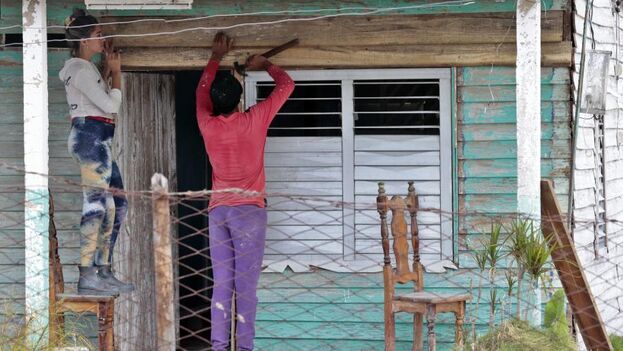
![]() 14ymedio, Madrid, 14 November 2022 — Pinar del Río’s recovery work after the passage of Hurricane Ian never ends. It has been almost 50 days since the hurricane landed in La Coloma, one of the westernmost points on the Island, and there are still 3,673 people without electricity, according to the latest update published this Sunday by the Electric Company in the province.
14ymedio, Madrid, 14 November 2022 — Pinar del Río’s recovery work after the passage of Hurricane Ian never ends. It has been almost 50 days since the hurricane landed in La Coloma, one of the westernmost points on the Island, and there are still 3,673 people without electricity, according to the latest update published this Sunday by the Electric Company in the province.
Pinar del Río has, according to official data, 235,311 customers, of whom 231,638 (98.44%) have recovered electricity. But in San Juan y Martínez, the tobacco cradle of the Island, and San Luis, most people continue to be without service.
“We buy food for one day, because if you do it for two or three days it spoils. We have to go to Pinar del Río (22 kilometres away) and get it ’from the left’ [’under the table’] or pay for it in MLC (freely convertible currency) because at the bodega (ration store) there isn’t any,” a resident from San Juan y Martínez told the Spanish agency EFE this weekend.
In her house, where the kitchen — like so many in Cuba — is electric, she has been buying coal and oil or cutting firewood for more than a month to be able to cook.
But this is not the only one of the shortages that this report has mentioned about the situation in Pinar del Río. José Ariel continues living in his half-fallen-down house and with no electricity. The pinareño received his first government visit one day before being interviewed by EFE, and the result couldn’t have been worse.
“We said we needed cement but (they said) there was none. They told us: ’you already have a roof, you already have a home’, and they don’t give you anything,” complains this fisherman who managed to put up some zinc plates as a roof with the help of neighbors and now must nail wood over the windows to cover the holes.
“We paid about 2,500 pesos for some pipes that arrived,” he added. In his case, the power came back two weeks ago, but the rest is a disaster.
Caridad Martínez, a 79-year-old resident in San Juan y Martínez, survives by selling honey in the doorway of her house. She explained that her bed is soaked because she can’t get any cement to plaster her ceiling.
“They told me that there was no need to give me anything,” said the retiree, also outraged by the resellers who proliferate on networks trying to sell the construction materials they manage to obtain illegally at unbearable prices. “They’re not ashamed; look, it’s already difficult to get things, but this is taking advantage of people,” she said.
The Government recently recognized that it would be very difficult for it to obtain in the short term all the materials for the reconstruction of the more than 108,000 homes partially or totally destroyed by the hurricane, and that only 7,000 have been repaired.
“More than a month after the hurricane, we are still discussing the same problems that we addressed on the first day,” Esteban Lazo, President of the National Assembly of People’s Power, said last weekend in one of the many visits that the leaders have made to the area, possibly in an attempt to calm the waters.
This same Sunday, Cuban President Miguel Díaz-Canel sent a message to piñareos via Twitter that contrasts with some of the eye-witness reports that the neighbors post on social networks, in press comments or in complaints to the press.
“The recovery from the effects caused by Hurricane Ian continues. In Cuba no one is left homeless,” the president said, sharing a tweet from the Minister of Energy and Mines in which he had written: “We continue to work until we reach everyone. Our workers have experienced the affection of a people who know about solidarity and commitment.”
Vicente de la O Levy, head of the branch after the dismissal of Liván Arronte, indicated that as of Saturday, 97.74% of customers already had electricity, and the linemen from Santiago de Cuba, who have for weeks been trying to recover the fallen poles and the miles of cables destroyed in Pinar del Río, have been advancing.
“What I still don’t understand is why they haven’t restored the electricity in Mantua, which has the generation plants for the municipality. They should do something, because we know that they use the profits like they want,” a Facebook user claimed, writing about the province’s electricity company.
“Please, can anyone tell me when they are going to turn on the power in the Pepe Chepe neighborhood like they did at La Espa?” says another. “Will they deign to pass at least through the P 990 circuit on Sol Street? With so many brigades distributed in Pinar, some could at least pass through here,” adds another.
And the worst thing is that the day the power arrives pinareños know that their problems, , will be far from over, as another user said. “They are working like crazy to reach 100% so they can start with the scheduled blackouts.”
Translated by Regina Anavy
____________
COLLABORATE WITH OUR WORK: The 14ymedio team is committed to practicing serious journalism that reflects Cuba’s reality in all its depth. Thank you for joining us on this long journey. We invite you to continue supporting us by becoming a member of 14ymedio now. Together we can continue transforming journalism in Cuba.
